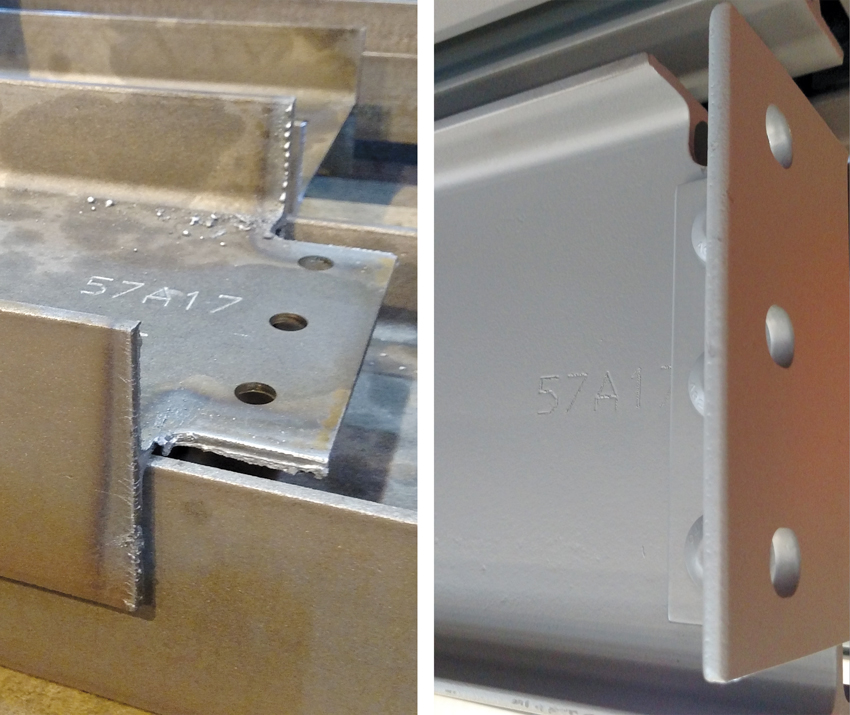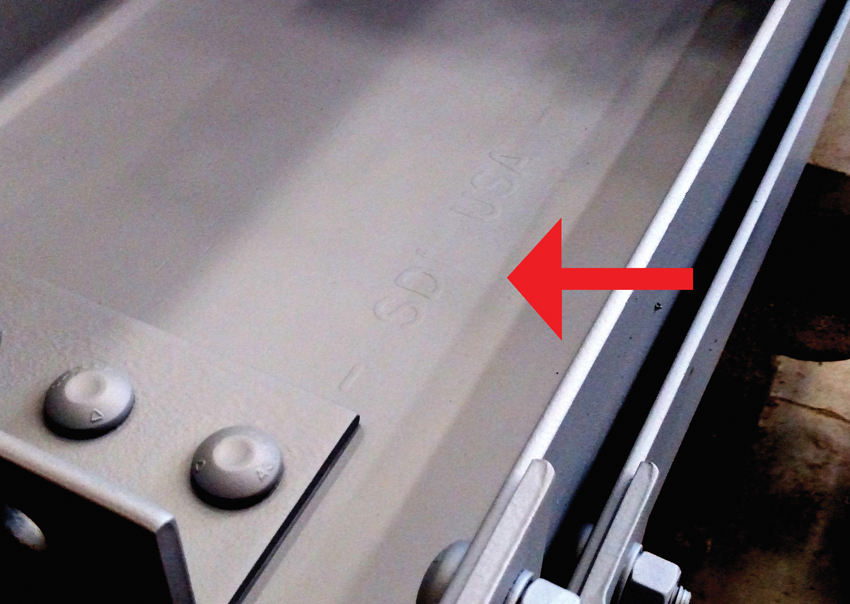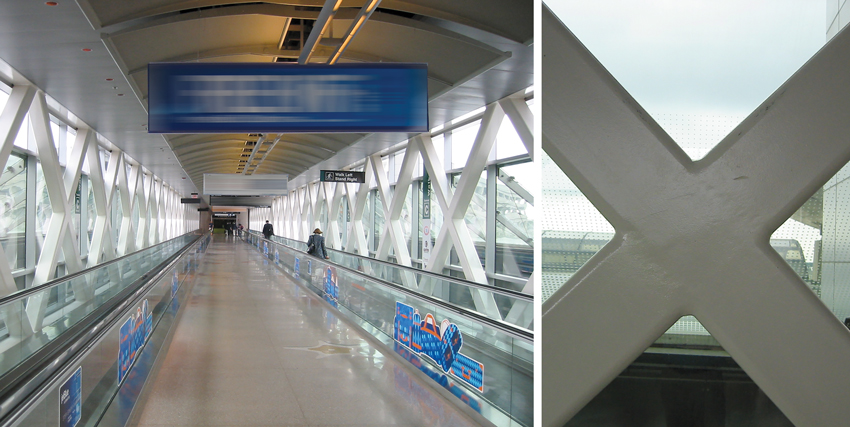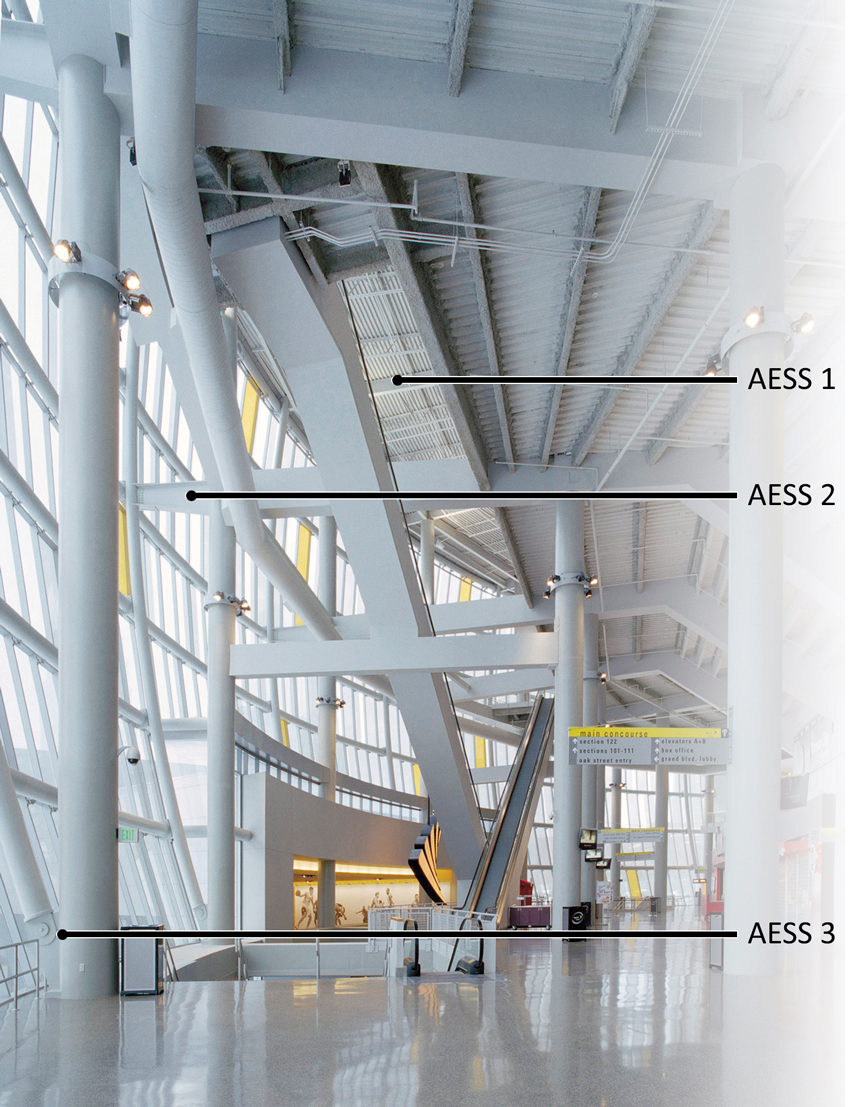Categorized by Design: Architecturally Exposed Structural Steel
AESS 2: Feature Elements not in Close View
It is important to recognize that details are much less visible at 20 feet away as compared to an element 5 feet away. AESS 2 serves a level of fabrication and erection specific to structural steel elements viewed from a distance greater than 20 feet. The intent of creating such a distinction is to establish the same level of expectations for elements that are deemed as AESS but are located further away. The cost range is typically higher than AESS 1, as it builds on the characteristics of the basic elements in addition to meeting more requirements.
AESS 2 is more refined than AESS 1, as it mandates fabrication tolerances for straightness be half that of standard requirements. This is especially important when adjacent materials and components must closely integrate with steel members in a design.

Photos courtesy of American Institute of Steel Construction (AISC)
Numbers are etched into a steel beam (left) during the fabrication process. After receiving a painted finish coat in the shop, the tracking number for the project can still be seen.
During fabrication and erection, steel members are marked for inventory and tracking purposes. These numbers are visible on the steel even through certain coatings unless AESS 2 or a higher category is specified. The marks can either be ground out, filled, or simply turned away from view.
Continuous welds are already included with AESS 1, but AESS 2 goes a step further by requiring greater consistency in the welding process. The latter expects additional care and refinement during fabrication and erection. AESS 2 calls for uniform and smooth welds, which entails a consistent appearance on all welds in view range but does not necessarily deem welds are to be ground smooth.
AESS 3: Feature Elements in Close View
A higher level of fabrication and erection is provided as the number of AESS category increases. AESS 3 represents the next level of characteristics, specifically for components within a viewing distance of 20 feet or less. This category includes all the requirements for AESS 1 and 2 along with a more specific attention to detail as exposed elements are visibly closer.

Photo courtesy of American Institute of Steel Construction (AISC)
Mill marks from Steel Dynamics Inc. (SDI) are visible through the painted finish on this structural steel member.
Steel is marked with slightly raised characters, called mill marks, when it is delivered to a fabricator from the mill. Mill marks identify the steel mill from which the component was produced. A raised or depressed surface on structural steel members is also created with butt and plug welds. These marks and visible welds are deemed undesirable in AESS 3 and are required to be removed from view, typically by grinding them out or filling any depressions. Grind marks on exposed steel are easily visible, but applying a surface coating nearly or completely eliminates their appearance.

Photos courtesy of American Institute of Steel Construction (AISC)
Weld seams are to be less visible and consistently located in AESS Category 3. A series of intersecting hollow steel sections are visible along the pedestrian bridge (left) at Boston Logan International Airport. A close-up view (right) slightly shows the weld seams, which have been ground out consistently at each architecturally exposed member and coated with intumescent paint.
A weld seam is typically apparent when steel is joined together by welding. Welds are required to be continuous and consistent in appearance as noted in categories AESS 1 and 2. It is required that weld seams are to be less visible in AESS 3, as these elements are much closer in view range. Hollow structural steel (HSS) often includes weld seams as a typical method of connecting steel. An option to reduce visibility of seams is to simply orient them away from view. When such a strategy is not available, then aligning the seams in a consistent manner across all members is another solution. There are multiple methods of fulfilling this requirement, some which are less costly than others.
When two cross sections of steel come together, such as a column splice with connection plates, it is critical the sections align when in close view range. Lighting showcasing an AESS component can expose misaligned surfaces in an obvious and undesirable manner. AESS 3 specifically addresses components within range of touch or within closer view distances up to 20 feet away. Misalignments are not acceptable and require greater care in fabrication and erection to avoid these issues at cross-sectional surfaces that abut one another.
The tolerance for straightness must be tighter than the standard level, as noted under AESS 2. Tolerance requirements in AESS 3 go further to minimize the gaps between the components that have bolted connections. Greater precision during fabrication and erection is required so that these gaps are no greater than 1/8-inch and are uniform among all adjacent components.
The appearance of a bolted connection is not always desirable, especially when trying to achieve a seamless, “plastic” look. Determining the style of aesthetic is a prerequisite of choosing the appropriate AESS category. AESS 3 includes an option to utilize all-welded connections or reduce in the appearance of bolts. This can be achieved by coordinating the design intent with the structural engineer to use only welds for a particular connection. An alternate solution may be to hide the bolts by placing cover plates over them, a detail which should be clearly expressed in the contract documents.










